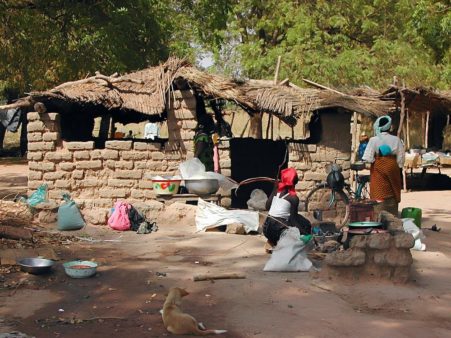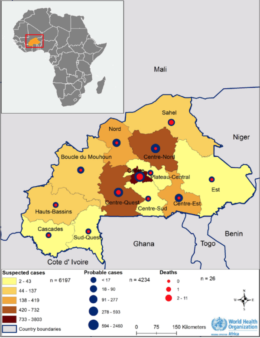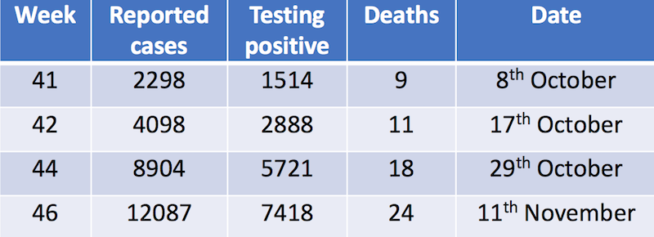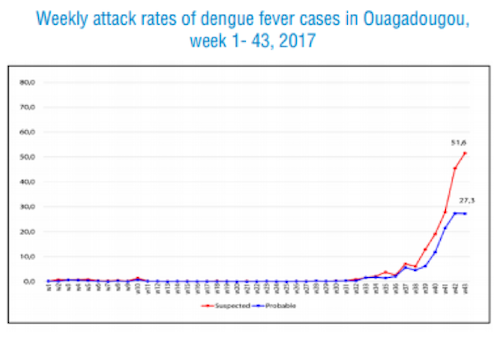- by Alison
Multiple serotypes increasing risks in dengue outbreak in Burkina Faso

A dengue outbreak in Burkina Faso that began in early August has resulted in more than 12,000 infections and 24 deaths. The country’s National Epidemic Management Committee is addressing the inadequate dengue surveillance and limited access to dengue diagnostics tools. But this outbreak is very different from past outbreaks in the African nation: there are now three different dengue serotypes at work – increasing the risk of severe dengue.
Health facilities in Burkina Faso began seeing a rise in dengue cases early in August following Burkina Faso’s rainy season. Mosquito breeding areas were plentiful, especially in cities. The World Health Organization (WHO) Africa Region identified “uncovered water drums, flowers pots, backyard orchards and banana plantations” as just some of the many sites suitable for mosquito breeding in its Week 44: Weekly Bulletin on Outbreaks and Other Emergencies published on 3rd November.

Image via WHO Africa
By the end of September, the Ministry of Health had officially declared an outbreak of dengue in the country. Since then, the disease has spread outwards from Ouagadougou, the country’s capital and the area most affected by the outbreak. Health facilities in all the country’s 13 health zones are now reporting cases.
The true extent of the dengue outbreak in Burkina Faso is to be determined. The WHO believes that “the disease has been spreading in the community for some time, without being noticed” and has found it “difficult to determine the true burden of the disease at this stage”.
In a risk assessment of the situation in its November 6th Disease Outbreak News, the WHO outlined some of the main hurdles that need to be overcome to tackle the outbreak: “This outbreak is occurring in the context of an improved but still limited dengue surveillance system in Burkina Faso. The weekly case incidence has been on the rise since the detection of the outbreak in week 31 and is likely underestimated.”
This is somewhat of an improvement on 2016 when the WHO noted, “low establishment of dengue surveillance in Burkina Faso”. It found “many health facilities do not have access to dengue RDT [Rapid Diagnostics Test]” and that “awareness of the disease among healthcare workers and prevention is lacking.”
Dengue outbreak in Burkina Faso, the numbers
Thankfully, the number of new cases reported each week is now starting to decline, down to around 1,500 cases a week mid-November from 2,500 new cases a week late in October.
The WHO Africa Region’s Week 46: Weekly Bulletin on Outbreaks and Other Emergencies published on 17th November reported 12,087 cases (including 7,418 testing positive) and 24 deaths as of 11th November. Just two weeks earlier, the Week 44 edition reported 8,904 (5,721 testing positive) cases and 18 deaths as of 29th October. Two weeks before that, the Week 42 edition published on 20th October reported 4,098 (2,888 testing positive) cases and 11 deaths as of 17th October.
Weekly reported dengue cases and deaths in Burkina Faso

Data source WHO Africa
Those weekly case numbers are likely to be an underestimate with surveillance of dengue in Burkina Faso falling short of what it needs to be, according to experts.

Severe dengue risk
This year’s dengue outbreak in Burkina Faso is notably different to the outbreak in 2016 when the country reported 1,266 cases (including 1,061 testing positive) cases and 20 deaths by mid-November. That outbreak was also less widespread than 2017 (spreading only to three regions including capital city Ouagadougou) and also only involved one serotype: DENV-2.
This year, the Viral Haemorrhagic fever (VHF) reference lab in Burkina Faso has identified three dengue virus serotypes in circulation. While around three-quarters of the specimens it analyzed were the DENV-2 serotype, it found the DENV-3 serotype in a significant number of specimens and the DENV-1 serotype in a small number of cases.
The WHO has warned multiple serotypes in circulation could “lead to the occurrence of more severe cases.” But why?
Anyone who has previously had dengue is protected against the serotype from that infection but at increased risk of severe dengue from other serotypes. If you, for instance, were infected with DENV-2 last year and caught DENV-1 this year, you would be at higher risk of severe dengue.
A coordinated response to managing the outbreak
When the Ministry of Health officially declared a dengue outbreak in Burkina Faso, it set the country’s National Epidemic Management Committee in motion. Responsible for coordinating the response to the outbreak, the committee is focusing on four goals: strengthening surveillance, identifying and treating patients promptly, intensifying vector control and raising awareness.
To strengthen surveillance:
• An Early Warning System provides prompt notification of dengue cases, daily in Ouagadougou and weekly in the other provinces.
To accelerate diagnosis and treatment:
• Regional health centers and hospitals have received 1,500 rapid diagnostic tests.
• Along with 1,500 long-lasting insecticidal nets to prevent the spread of dengue from patients to mosquitoes and mosquitoes to patients.
• Patients with severe dengue can access free medical care and treatment.
• Staff numbers have been increased at the national reference hospital in Ouagadougou.
• The hospital is also receiving training for its laboratory staff and medicine.
• Healthcare providers have received treatment guides and posters.
In terms of vector control:
• Sites in Ouagadougou with high densities of Aedes aegypti are being sprayed as part of an intensive vector control programme.
• 5,500 community volunteers in Ouagadougou have been trained to identify and destroy mosquito breeding sites in homes.
And when it comes to raising dengue awareness:
• A public information campaign is disseminating information about dengue via radio, TV and social media.
• The press has been briefed to increase the coverage and accuracy of messages around the prevention and control of dengue.
These activities are aligned with WHO’s view that “active surveillance, effective vector control, case management, and social mobilization are particularly critical for the control of this outbreak.”
But, even though case numbers are gradually coming down, the WHO still has some concerns: “Specifically, there is a lack of financial resources to continue vector control activities, including the campaign currently ongoing in Ouagadougou.”
As we have seen in other cases, combating dengue requires a combination of approaches: surveillance, vector control, case management and community mobilization. With the help and support of the WHO and other relief organizations, we are hopeful that the situation in Burkina Faso will continue to improve.
—
Click below to create a record of dengue activity near you that can help experts learn more about this disease.

